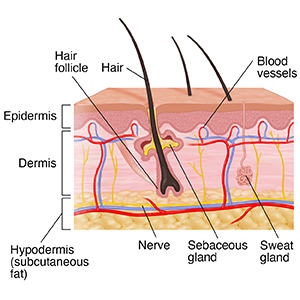Burns
What are burns?
Burns are painful wounds caused by thermal, cold, electrical, chemical, or electromagnetic energy. Smoking and open flame are the leading causes of burn injury in adults. Scalding is the leading cause of burn injury in children. Both infants and older adults are at the greatest risk for burn injury.
What are the different types of burns?
There are many types of burns caused by thermal, cold exposure, radiation, chemical, electrical, or friction contact.
-
Thermal burns. These burns are due to heat sources which raise the temperature of the skin and tissues. They cause tissue cell death or charring. When hot metals, scalding liquids, steam, and flames come into contact with the skin, they can cause thermal burns.
-
Cold exposure burns (frostbite). Damage to the skin is caused by exposure to cold.
-
Radiation burns. These burns are due to prolonged exposure to ultraviolet rays of the sun, or to other sources of radiation such as X-ray.
-
Chemical burns. These burns are due to strong acids, alkalis, detergents, or solvents that come into contact with the skin, eyes, mouth, or gastrointestinal tract.
-
Electrical burns. These burns are from electrical current.
-
Friction Burns. These burns are from mechanical friction.
How are burns classified?
Burns are classified depending on how deep and severely they penetrate the skin's surface.
-
Superficial (first-degree) burns. Superficial burns affect only the epidermis, or outer layer of skin. The burn site is red, painful, dry, and with no blisters. Mild sunburn is an example. Long-term tissue damage is rare and usually involves an increase or decrease in the skin color.
-
Partial thickness (second-degree) burns.
-
Superficial partial thickness burns involve the epidermis and part of the superficial dermis layer of skin. The burn site appears red, blistered, and is wet. It may be swollen, and the pain can be severe.
-
Deep partial-thickness burns involve the deeper dermis. The burn site appears yellow or white and dry. There may be minimal pain due to decreased sensation.
-
Full thickness (third-degree) =burns. Full thickness burns destroy the epidermis and dermis, and often injure the subcutaneous tissue. The burn appears white or blackish brown and is leathery and dry. There is minimal to no pain because of decreased sensation.
-
Extension to deep tissue (fourth-degree) burns. Fourth-degree burns damage the underlying bones, muscles, tendons, or a combination of these. The burn site looks white or charred and bone may be exposed. There is no feeling in the area because of nerve damage.

Burns that are more severe and widespread need specialized treatment. The age of a burn victim, the location of the burn, and the percentage of the body's surface area affected are the most important factors affecting the outlook of a burn injury. The American Burn Association recommends that those who meet these criteria should be treated at a specialized burn center:
-
People with partial-thickness burns over 10% or more of the total body surface area
-
Any age with full-thickness burns
-
Burns of the face, hands, feet, groin, or genital area, or burns that extend all the way around a part of the body
-
Burns that happen along with an inhalation injury that affects the airway or the lungs
-
Burns that occur with existing long-term (chronic) conditions that may greatly affect how the burn heals. These conditions include diabetes, high blood pressure, heart disease, kidney disease, and multiple sclerosis.
-
Suspected child or elder abuse. This person will need social, emotional, or rehab help
-
Chemical burn
-
Electrical injury
The effects of burns
A severe burn can be a seriously devastating injury, both physically and emotionally. It can affect the burn victim and their family. People with severe burns may be left with a loss of certain physical abilities. These may include loss of limb(s), disfigurement, loss of mobility, scarring, and recurrent infections. Severe burns can also penetrate deep skin layers. This can cause muscle or tissue damage that may affect every system of the body.
Burns can also cause emotional problems, such as depression, nightmares, or flashbacks, from the traumatizing event. The loss of a friend or family member and possessions in the fire may add grief to the emotional impact of a burn.
The burn rehab team
Because so many functions and systems of the body can be affected by severe burns, the need for rehab becomes even more crucial.
Many hospitals have a specialized burn unit or center, and some facilities are designated solely for the rehab of burn patients. Burn patients need the highly specialized services of medical professionals who work together including:
-
Physiatrists
-
Plastic surgeons
-
Internists
-
Orthopedic surgeons
-
Infectious disease specialists
-
Rehabilitation nurses who specialize in burn care
-
Psychologists and psychiatrists
-
Physical therapists
-
Occupational therapists
-
Respiratory therapists
-
Dietitians
-
Social workers
-
Case managers
-
Recreation therapists
-
Vocational counselors
The burn rehab program
Burn rehab starts during the acute treatment phase. And it may last days to months to years, depending on the extent of the burn. A burn rehab program aims to help the person return to the highest level of function and independence possible. It also hopes to improve overall quality of life physically, emotionally, and socially.
To help reach these goals, burn rehab programs may include:
-
Complex wound care
-
Pain management
-
Physical therapy for positioning, splinting, and exercise
-
Occupational therapy for assistance with activities of daily living (ADLs)
-
Cosmetic reconstruction
-
Skin grafting
-
Counseling for the victim and family to deal with common emotional responses during healing, such as depression, grieving, anxiety, guilt, and insomnia
-
Education and counseling
-
Nutritional counseling
Advances in the treatment of burns has contributed to the increase in the survival rate and recovery of burn patients.